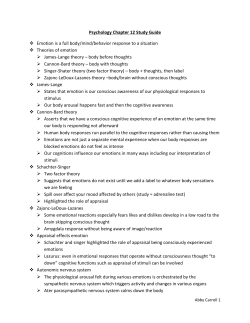
Chapter Fourteen Emotion 1
Chapter Fourteen Emotion 1 Can You Label These Emotions? Courtesy Dr. Paul Ekman 2 What is an Emotion? Emotions subjective experiences that arise spontaneously and unconsciously in response to the environment around us. Emotions have two components: physical reaction (rapid heartbeat, etc.). conscious experience or feeling (sadness, anger, etc.). 3 Purposes of Emotion Arousal Communication The Yerkes-Dodson Law 4 Are emotions innate or learned? Across diverse cultures Blind vs. sighted infants Infants separation from mothers Conclusion? 5 But…Cultural contributes to expression also Doctors Expressiveness in group situations American students Japanese students Display rule: A culturally determined rule that modifies the expression of emotion in a particular situation. 6 Individual Differences Temperament differs at birth Very responsive babies Low responders Psychopaths are extremely nonresponsive, possibly leading to lack of empathy. 7 How do we express emotions? Innervation of the Facial Muscles The trigeminal nerve (cranial nerve V) The facial nerve (cranial nerve VII) upper face: lower face: Conclusion: 8 Voluntary and Involuntary Expressions Use Different Pathways Voluntary expressions (smile for the camera) involve primary motor cortex People with cortical damage can smile spontaneously, but not on command Volitional facial paresis: Right side Left side 9 Voluntary and Involuntary Expressions Use Different Pathways Spontaneous expressions (smiling at a joke) involve pathways in pons and medulla People with extrapyramidal damage can smile on command, but not spontaneously. Emotional facial paresis: 10 Which comes first, feeling or physiological response? 11 James-Lange Theory of Emotion Emotion arises from physiological arousal Kassin, S. (2001). 12 Cannon-Bard Theory of Emotion “Body” (physiological systems) and “Mind” (emotional experience) are independently activated at the same time 13 Schachter’s Two-Factor Theory of Emotion Physiological arousal Sweaty palms Increased heart rate Rapid breathing Cognitive Label Attribute source of arousal to a cause. 14 Theories of Emotion and the Capilano Bridge Experiment Men confused fear of the bridge with sexual arousal. James-Lange assumes that emotions produce distinct physical responses, so results here do not support this theory. Cannon-Bard and Schachter would predict these results. © Ted Streshinsky/CORBIS 15 Theories of Emotion and Hohmann’s Spinal Patients Hohmann reported more emotionality in men with lumbar damage than in men with cervical damage. Supports James-Lange provision regarding the importance of autonomic feedback. Less consistent with Cannon-Bard and Schachter. 16 Theories of Emotion and Catharsis Catharsis: expression reduces emotion. Expressing an emotion reinforces the feeling. Maori haka moves used by the New Zealand All Blacks Consistent with James-Lange Imitation as the basis of empathy © Reuters/CORBIS Focus New Zealand Photo Library 17 Arousal in the Autonomic Nervous System “Fight or Flight” Restore Calm 18 Lie Detectors Are Unreliable “mistakes” 19 Can We Spot Liars? Timing (real emotions are fast, spontaneous) “Match” between body language and verbal cues Lying reduces articulation Less upper body movement, more lower body movement Nervous laughter Eye contact is a clue in the US, but not in all cultures 20 Brain Mechanisms of Emotion: The Limbic System Modern definition includes: orbitofrontal cortex nucleus accumbens hypothalamus septal area amygdala 21 The Amygdala and Emotion Klüver-Bucy syndrome reduces fear. Human damage to the amygdala produces difficulty identifying fear and anger. The amygdala contains many benzodiazepine receptors (where sedatives like valium work). Stimulation can produce fear and anxiety. Imaging studies show more activity in the amygdala when viewing expressions of fear. 22 Is Cognition Necessary? Pathway for Fear Without “Thought” Sensation of threat can reach the amygdala via direct path from thalamus The fast “low road” Sensation of threat also travels from the thalamus to the cortex The slow “high road” Cortical judgment can override direct path 23 The Cortex and Emotion Clinical observations of frontal lobe damage (e.g. Phineas Gage) Frontal lobotomies Hemisphere lateralization for emotion Left hemisphere damage results in depression Dichotic listening tasks 24 Hemisphere Lateralization for Emotion Influences Perception Which face looks happy? Which face looks sad? The right hemisphere usually “reads” emotion. 25 Reprinted with permission from Neuropsychologia, © 1978 Pergamon Press The Emotional Right Hemisphere Produces More Expression on the Left Side of the Face Two right sides Two left sides 26 Different Emotions Produce Patterns of Brain Activation Feeling excluded from a game produced activity in the cingulate gyrus, an area that responds to physical pain. Recreating feelings of anger, happiness, sadness and fear produced distinct patterns of brain activation, but single areas could participate in more than one emotion. 27
© Copyright 2025





















